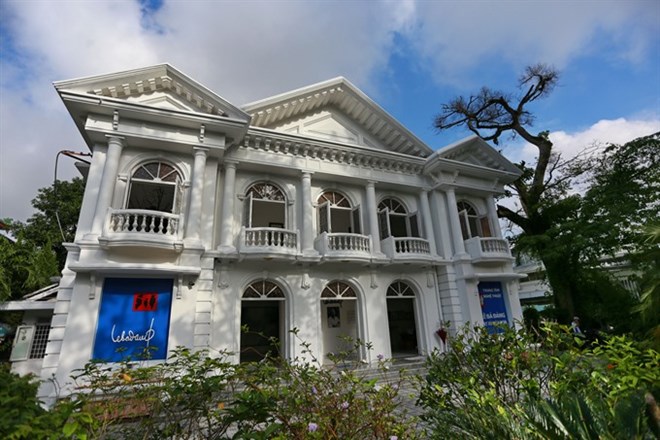
Researchers in the former imperial capital city of Hue have voiced their concerns over the new list of 27 prominent ’Indochinese colonial-style’ architectural buildings in the city.
The building designated for artist Le Ba Dang (Photo: VNA).
According to them, the list includes buildings that are not made in the colonial style while it excludes several buildings built during the French colonial period in the city. The researchers have demanded the elimination of those buildings from the list that have not maintained their status quo due to recent conservation work.
Phu Cam Cathedral, which is included in the list, is said to have a contemporary architectural style. "The cathedral was originally built in the colonial style, but it was knocked down in 1960 to be constructed into a new building, which was completed in 2000. Hence, it cannot be a colonial building,” said researcher Nguyen Xuan Hoa, former director of the local Department of Culture.
He added that the Morin Hotel and Memorial Pavilion for World War Martyrs should also be removed from the list due to changes in their structures and colours.
The original Morin Hotel was built in 1901 with two floors, but later in the 2000s, it was upgraded to four storeys. The Memorial Pavilion was built in 1920, with the inscription bearing the names of 78 Vietnamese and 31 French who had died during World War I. However, conservation work in 2017 destroyed all the inscriptions and changed the colour as well as many architectural patterns on the memorial.
Researcher Tran Dinh Hang, Director of the Vietnam Institute for Culture and Arts Studies in Hue, agreed with Hoa and said the Memorial Pavilion should not be included in the list as it had been changed.
Hoa, meanwhile, questioned why a 100-year-old typical colonial building, located on Le Loi Street, was not included in the list. This building serves as the office of the local Association of Culture and Art. "It is a typical, beautiful building and was the landmark of cultural historical events in Hue,” Hoa said.
The building is listed as one of the targets to be demolished to acquire land for a hotel.
Hang expressed his reservations about the list prepared by the provincial People’s Committee, which said the list was to enhance the conservation of the colonial buildings in the city. Hang said several colonial buildings that were not included in the list were targeted for demolition.
Earlier this month, the provincial People’s Committee had announced a list of 27 prominent Indochinese colonial-style buildings, saying that these buildings will be protected from land revamp for business structures.
Buildings in the list include those built by French colonialists, such as the railway station, Quoc Học School where President Ho Chi Minh used to study, it’s neighbour Hai Ba Trung School and the twin buildings that serve as offices of the Hue Museum of Culture.
Hang said the committee’s efforts to recognise the colonial buildings came late as tens of typical colonial buildings on the streets of Le Loi, Hoang Hoa Tham and Ly Thuong Kiet had already been knocked down to construct new buildings.
According to a study of the Central Region Institute for Constructional Science and Technology, there are some 200 colonial buildings located around Hue. Colonial buildings are part of the architectural history of the city, but few have maintained their original architecture due to changes in the trends of construction.-
Source: VNA
Gongs hold a special place in the cultural and spiritual life of the Muong ethnic people in Hoa Binh province. More than musical instruments, they are an indispensable part of community rituals and collective memory, echoing through generations as a spiritual thread linking the past, present, and future.
Preserving and promoting the cultural values of the Muong ethnic group has become an urgent task in the current context, as many traditional values face the risk of fading away. This effort requires not only protecting the cultural identity but also eliminating outdated customs and developing a modern cultural lifestyle, contributing to sustainable values for the Muong community in Hoa Binh province.
The Muong ethnic culture, deeply rooted in Vietnam’s mountainous north, continues to be preserved and revitalised by dedicated individuals and communities determined to safeguard their ancestral identity.
The Muong group is one of the largest ethnic minorities in Vietnam, primarily found in Hoa Binh province. The Muong people in Hoa Binh boast a rich and diverse cultural treasure that reflects the unique identity of this ethnic group. Accounting for over 63% of the province's population, they have created and preserved numerous distinctive cultural values, contributing to their unique identity. Their cultural heritage is an invaluable asset, at the heart of their national identity, and represents a vibrant spiritual life that must be preserved and promoted in today’s modern world.
For generations, the ethnic communities of Hoa Binh province, particularly the Muong people, have preserved vibrant festivals deeply intertwined with the region’s geography, nature, and social traditions. These celebrations enrich Hoa Binh’s spiritual life and cultural identity, reflecting both folk beliefs and the intermingling of ethnic customs. Many of these festivals have endured the test of time, passed down through generations and continuing to thrive today. Among them, the Khai Ha (Going Down to the Field) festival stands out as one of the most significant events of the Muong ethnic group.
Muong calendar, known as sach doi, is an ancient folk knowledge system developed through observations of the movement of the pleiades star. This unique calendar consists of 12 bamboo sticks, each representing a lunar month. Specific days within each month are marked with distinct symbols, guiding locals in determining auspicious and inauspicious days for important activities.


